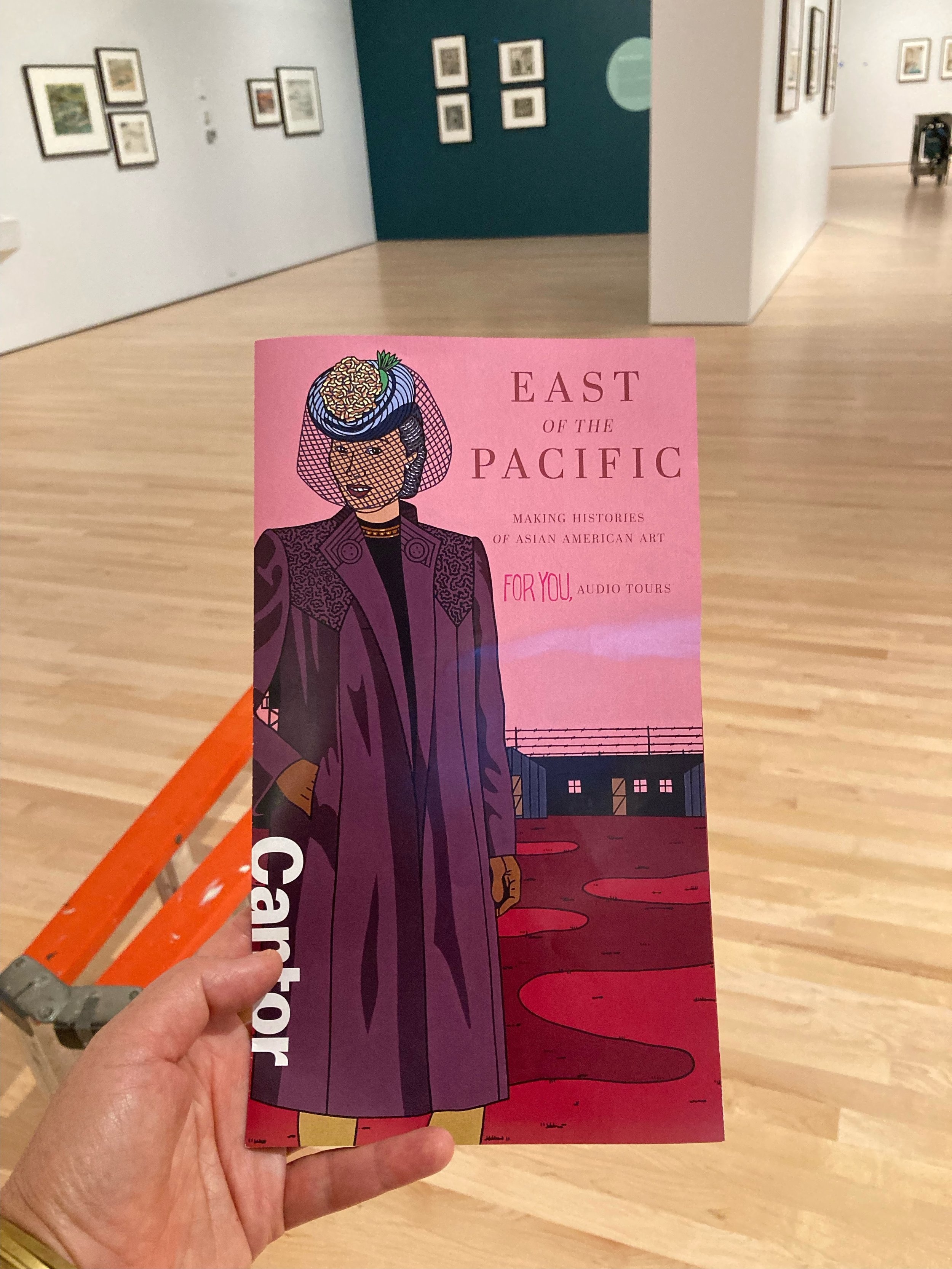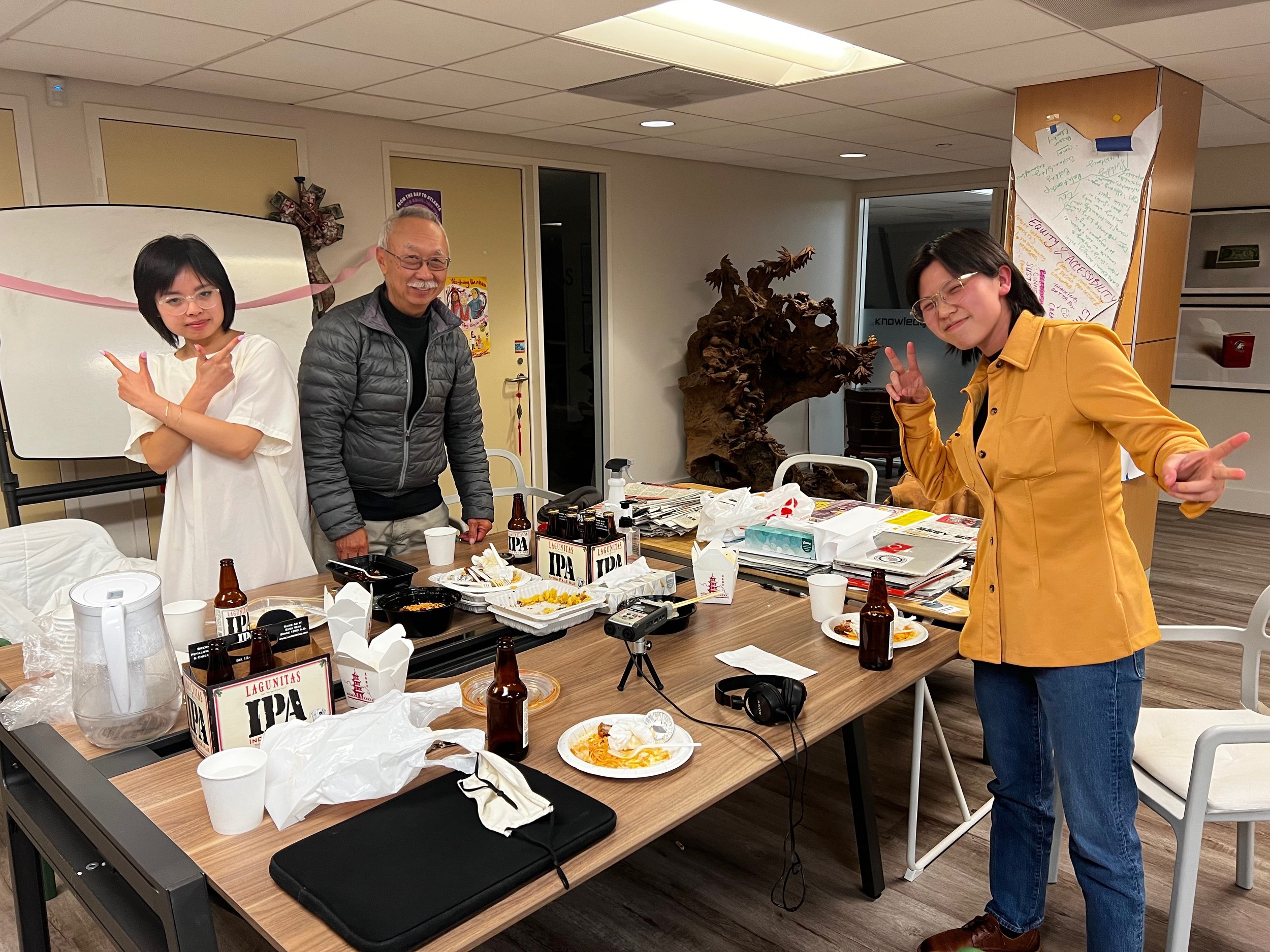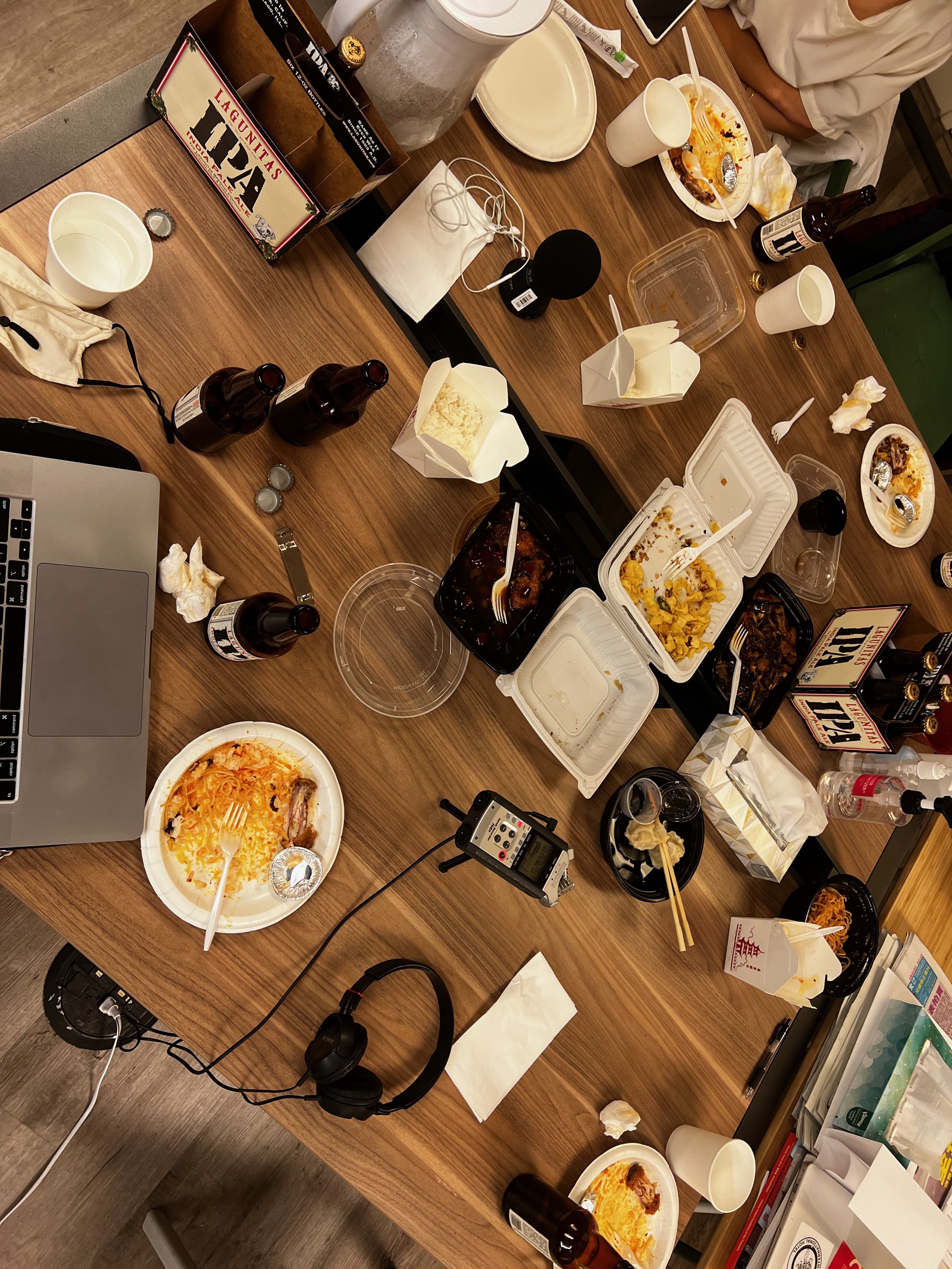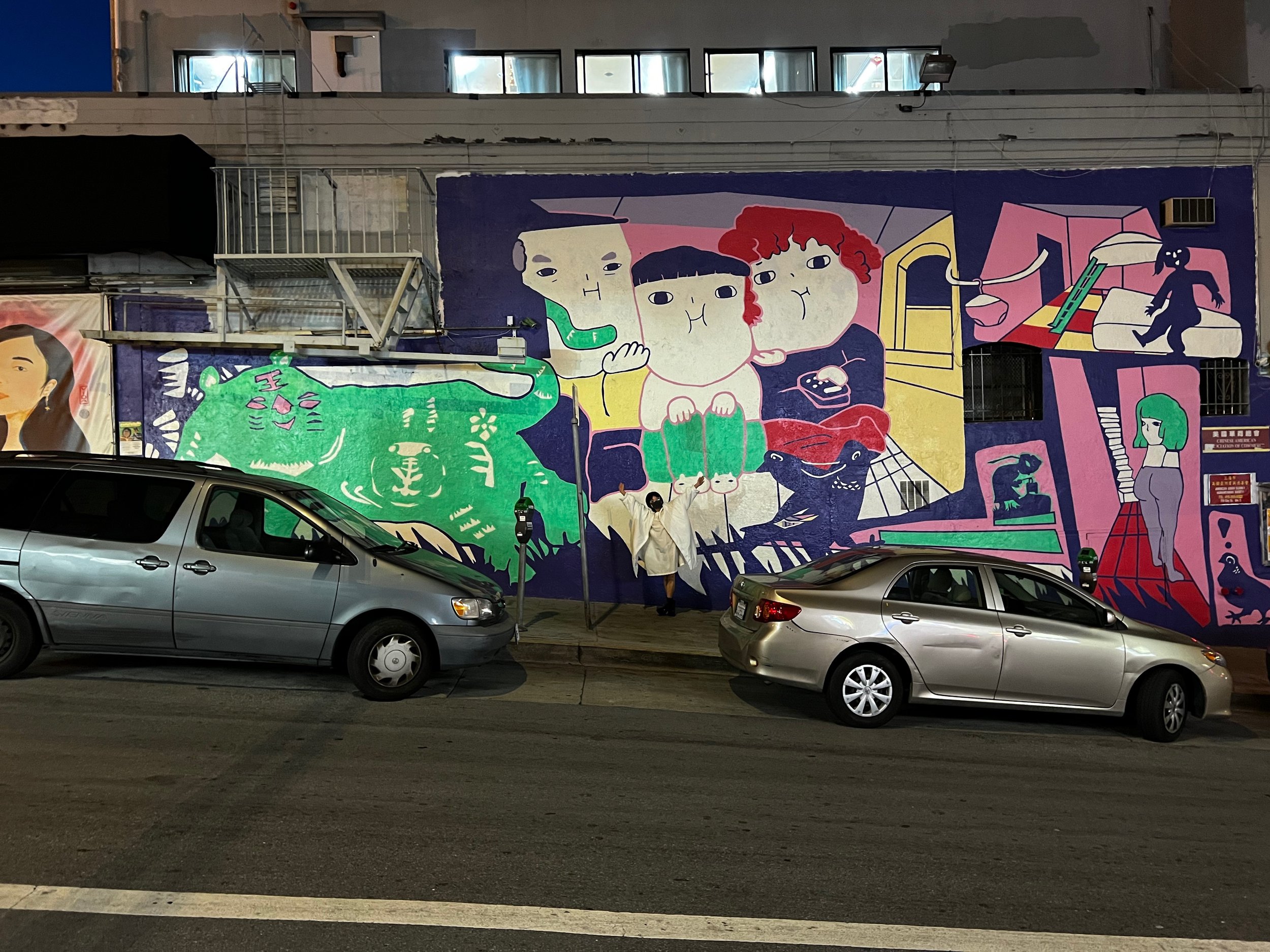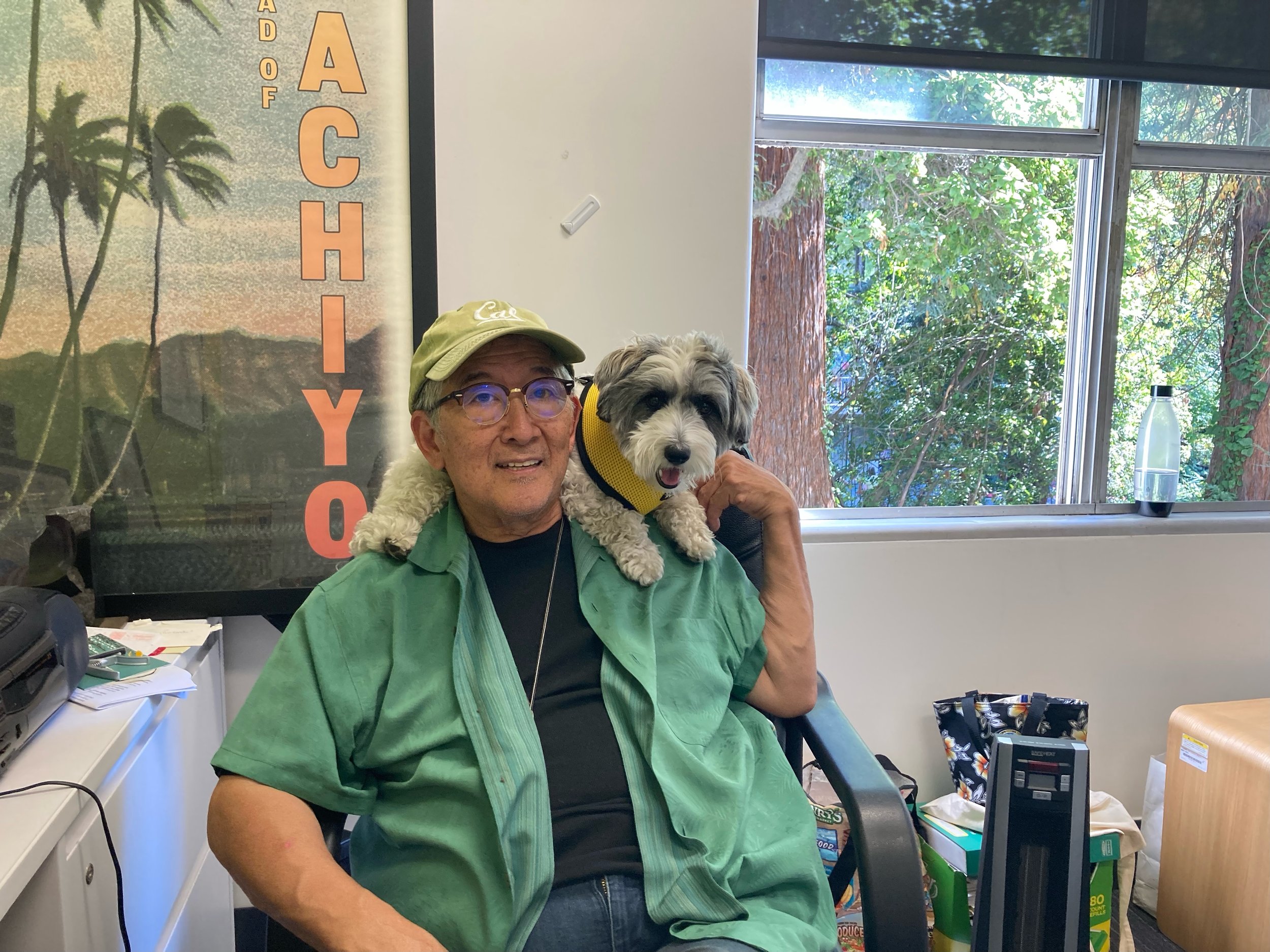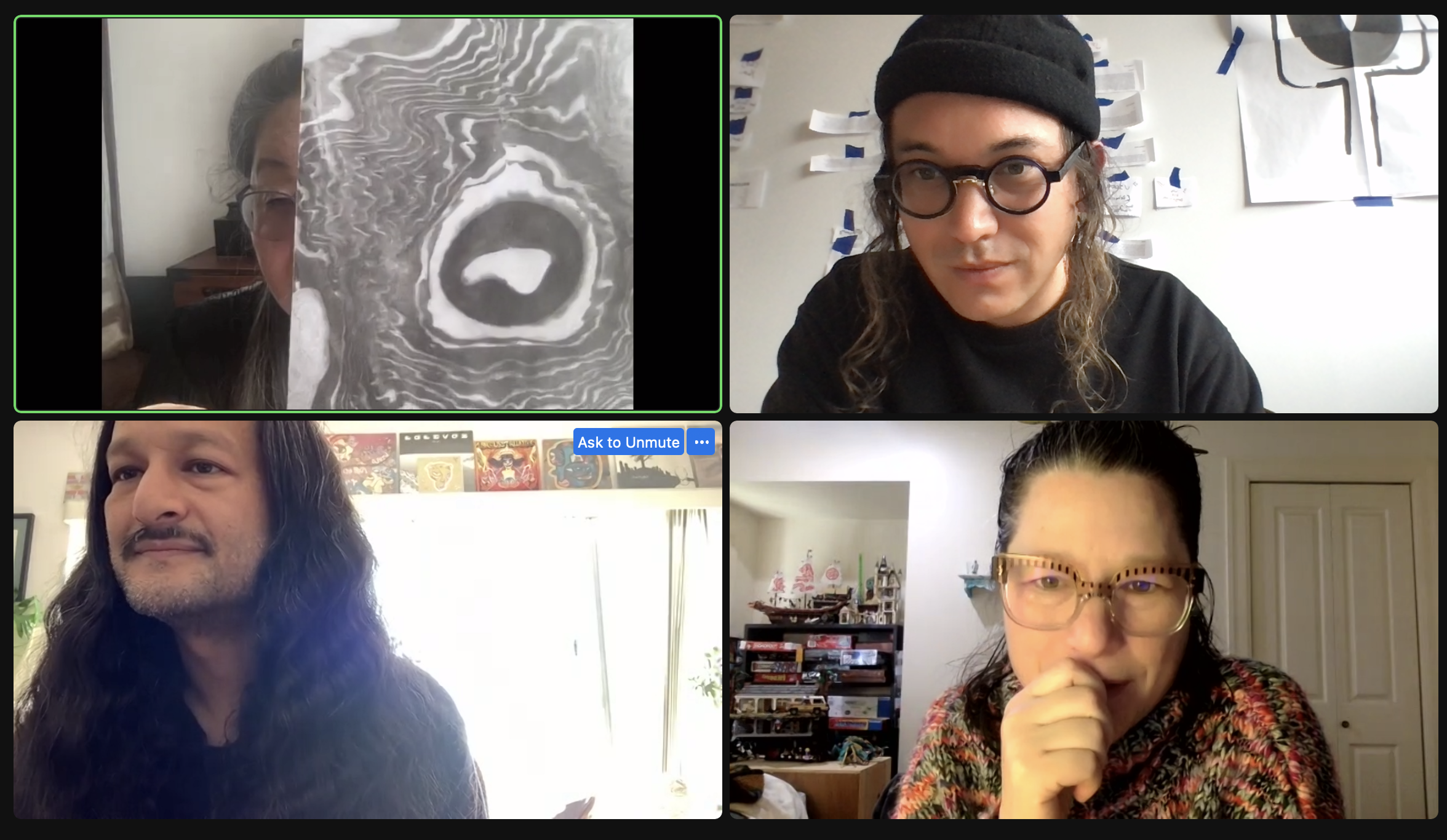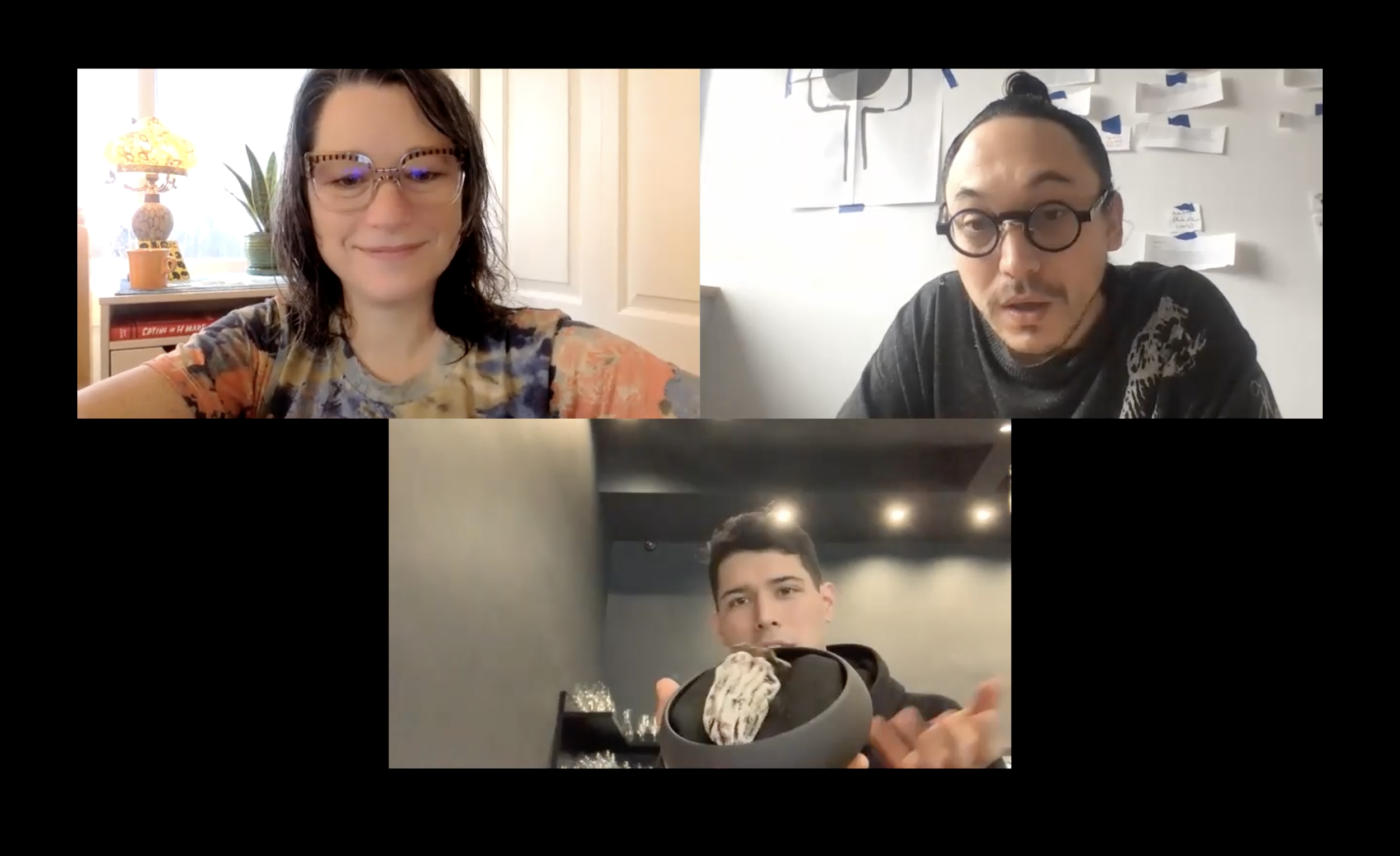Put on your headphones. Open the brochure to choose a tour. Place yourself at ▲START before pressing play.
I. MASAKO TAKAHASHI
II. A DINNER PARTY IN CHINATOWN
III. LUSH
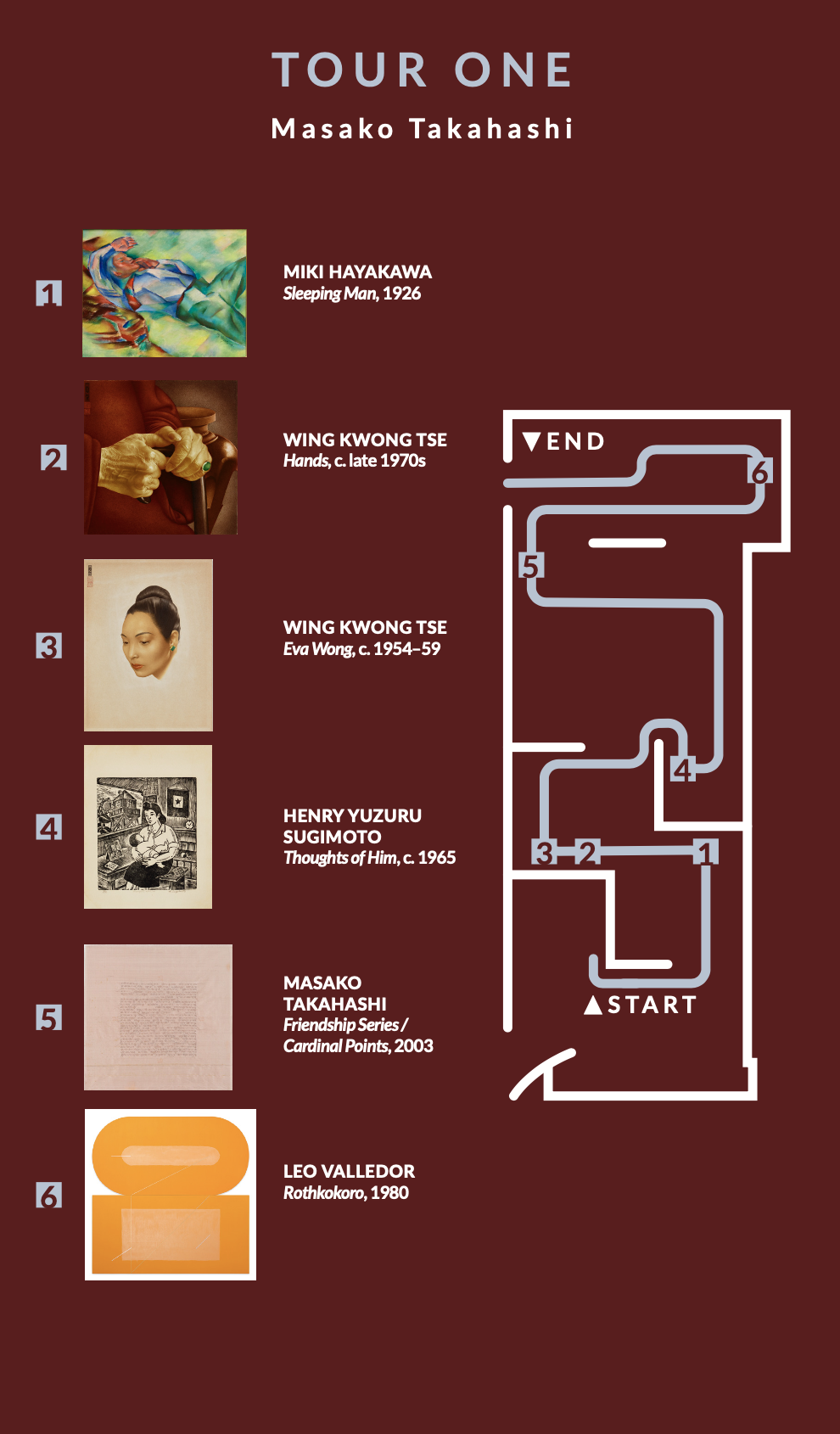
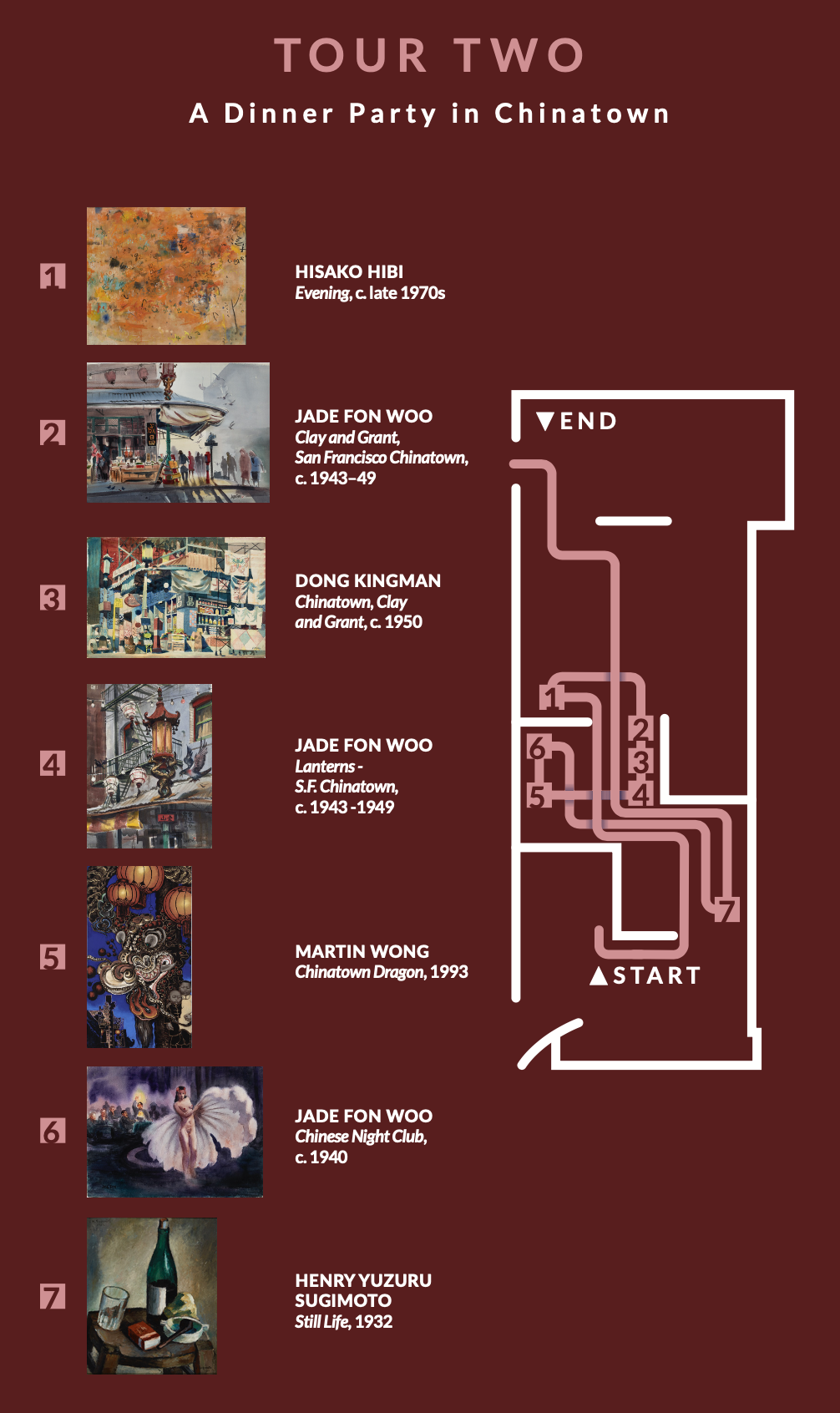

EAST OF THE PACIFIC
Making Histories of Asian American Art
Bespoke Audio Tours for the Asian American Art Initiative, Cantor Arts Center, Stanford University
September 28, 2022 – January 29, 2023
From January to August 2022, we met with several Asian American and Pacific Islander folk based in the San Francisco Bay Area to share meals and tips, like how best to enjoy a persimmon and strategies for focusing one's rage. We heard: Two lovers meet at the 1939 World’s Fair Japan Pavilion and craft a dream of importing beautiful things. A mother’s knuckles swell with arthritis as she brushes her very long hair. The spiritual revival of San Francisco’s Chinatown can be felt at Clay and Grant as rolling bags strike the pavement, hammering out new forms of the neighborhood under the buzz of gossip and neon lights. Persimmons, we are told, are best enjoyed when they’re slightly bruised and delicate to the touch. A selection of artworks from Stanford’s East of the Pacific exhibition served as our conversation prompts—and as with any good time spent between new friends, we found ourselves journeying into the personal, the mundane, and the fantastic. From these recorded conversations, we devised three audio tours that share a life with the exhibited works, not as descriptions, but as a chorus of lived experience that brings space to memory through visceral detail. Your guides include Masako Takahashi (artist featured in East of the Pacific), David Yoshimura (chef, Nisei), David Mas Masumoto (writer and farmer), Philip Kan Gotanda (playwright), Hoi Leung (curator, Chinese Culture Center of San Francisco), Bijun Liang (installation and media artist), and Leon Sun (artist and activist). Original musical compositions by Werd Pace transport us across medium, time, and space. Through these unique sonic tracks, we offer you three windows through which to view these artworks in the exhibition.
About the Exhibition
East of the Pacific: Making Histories of Asian American Art is the largest of the three inaugural Asian American Art Initiative (AAAI) exhibitions opening at the Cantor Arts Center in 2022. Curated by assistant curator of American Art, Aleesa Pitchamarn Alexander, this historical survey showcases the Cantor’s ever-growing collection of Asian American art, the majority of which was acquired since 2018. Organized thematically and chronologically, the 96 objects presented in East of the Pacific span a broad range of time (1880 – 2021), offering a rare opportunity to engage with historic Asian American material. East of the Pacific asks: what it would mean to consider a history of the United States as one of Eastern expansion from Asia? How might we reorient our understanding of what constitutes Asian, and what constitutes American, through looking at artists who worked between these worlds? This exhibition argues that the continental United States’ western coast was—and continues to be—fundamentally shaped by its interactions with Asia, which is especially evident in its artistic production. Though long overlooked by mainstream art institutions, Asian diasporic artists have helped shape and advance the course of American art, serving as vanguards, teachers, and activists within their communities and beyond. Works in East of the Pacific were acquired from a variety of sources. A significant percentage of the objects presented came from the estate of Michael Donald Brown, a Bay Area arts dealer and collector who amassed an unparalleled collection of pre-1950 Asian Californian art. Many gifts of art reflect the generosity and support of larger Bay Area arts and AAPI communities: living artists, historic artists’ estates, Japanese incarceration survivors, and contemporary art collectors all contributed to this exhibition. The provenance of these objects tells stories about how Asian American art has been created, cared for, and preserved—demonstrating that history-making is an active and ongoing process.
Audio Guides
Masako Takahashi grew up in San Francisco. She won a scholarship to the SF Art Institute, and found her tribe—artists. A vacation in Mexico turned into a move there, where she switched from painting to embroidery. Using her hair instead of thread, she created a new alphabet—giving her the freedom to express herself abstractly. The 2021 discovery and unfortunate desecration of the Wakasa Memorial Stone at Topaz (her birthplace, a Utah concentration camp) shocked her into feeling the intergenerational trauma already encoded in her hair’s DNA.
Hoi Leung is the Deputy Director of the Chinese Culture Center, overseeing the internal culture, programs and operations of the organization. Leung was born in Hong Kong and immigrated to the US in 2004. Previously, Leung was the Curator at CCC for 4 years, where she established a distinct practice specializing in Asian diasporic contemporary art, developing emerging artists, and designing community engagement in immigrant neighborhood settings.
Bijun Liang is an interactive media and installation artist from Chinatown San Francisco. Bijun reimagines the everyday to recognize the hidden "!" moments that are often ignored or forgotten.
Leon Sun was born in China and came to the U. S. in 1966. He is a photographer, painter, graphic designer, and printmaker. His art was mostly an expression of political activism but around 2000, art became his spiritual practice. He explores Asian and indigenous cultures for their take on nature.
Chef David Yoshimura (Nisei, SF) began his professional career as a cook in New York City, working at wd~50 for several years up until its closure. He has also staged abroad at many notable restaurants such as Kagurazaka Ishikawa, Nihonryori Ryugin, and Asador Etxebarri. After NYC, Chef David joined the team at Californios in the restaurant's first year open and helped attain their first Michelin star within six months. With the help of his team at Californios, David Yoshimura later passed his Certified Sommelier exam to expand his knowledge of wine and beverages. Upon leaving the now two Michelin star restaurant Californios, David has focused his goals on opening this restaurant with his eclectic experience to bring the Bay Area a new approach to Japanese-American food.
Mas Masumoto is an organic peach, nectarine, apricot, and grape farmer near Fresno, California. He has written thirteen books including award winning Epitaph for a Peach and Wisdom of the Last Farmer. His newest book, Secret Harvests, is about a family history of struggles, disabilities and secrets.
Philip Kan Gotanda has been instrumental in bringing stories of Asians in the U.S. to mainstream American theater as well as to Europe and Asia. Mr. Gotanda holds a law degree from Hastings College of Law and studied pottery in Japan with the late Hiroshi Seto. Mr. Gotanda’s newest work is the libretto for the chamber opera, Both Eyes Open, in collaboration with New York based composer, Max Duykers. beo-opera.com
Commissioned by Stanford University as part of Ryan Tacata and Erika Chong Shuch’s Visiting Artist Residency (21-22) with the Office of the Vice President for the Arts; hosted by the Asian American Art Initiative (a program of the Department of Art & Art History and the Cantor Arts Center), and supported by the Center for Comparative Studies in Race & Ethnicity.

